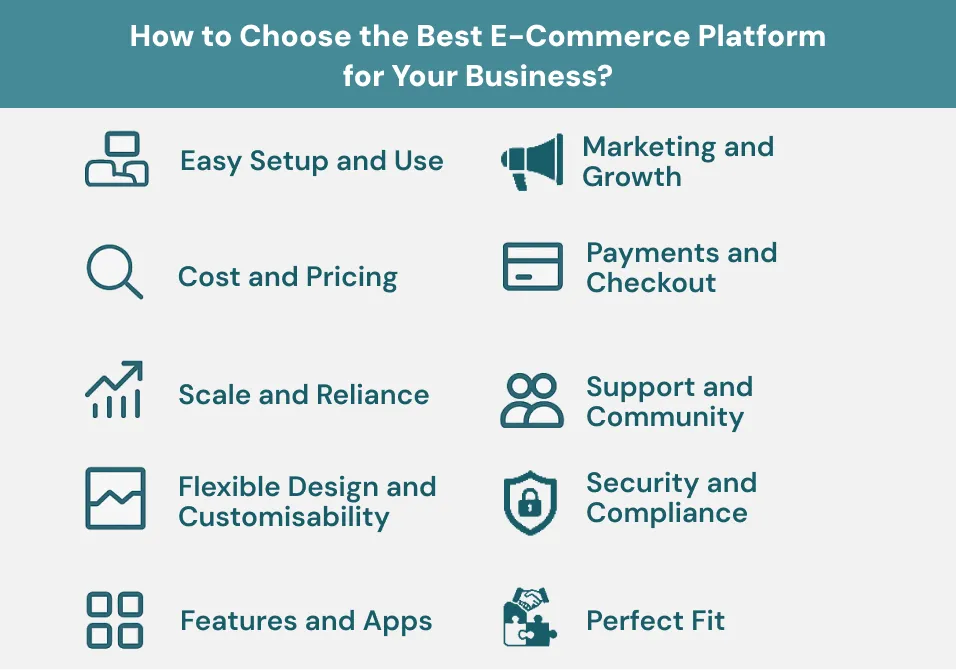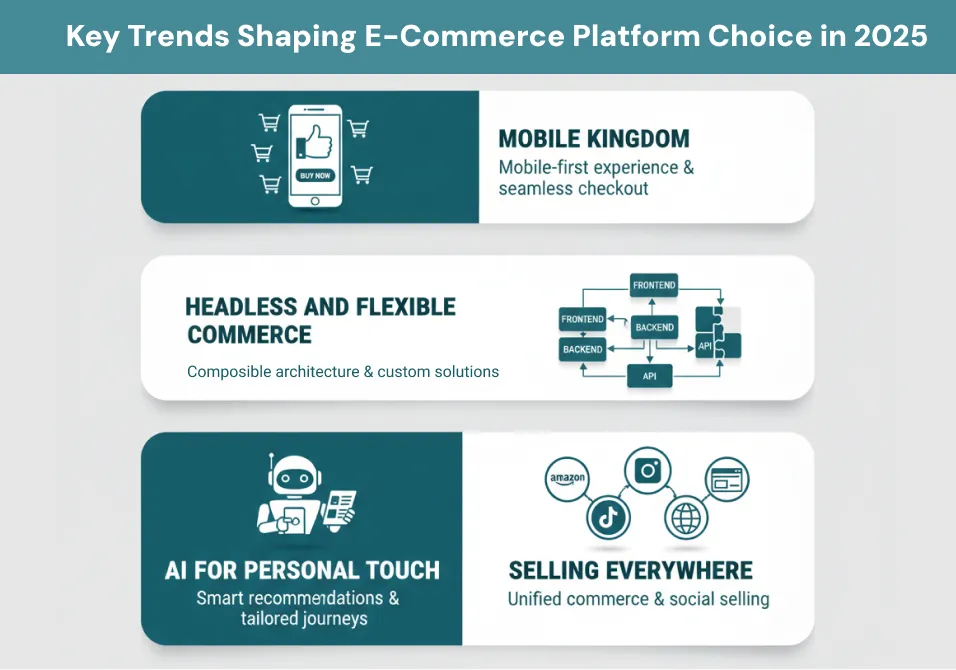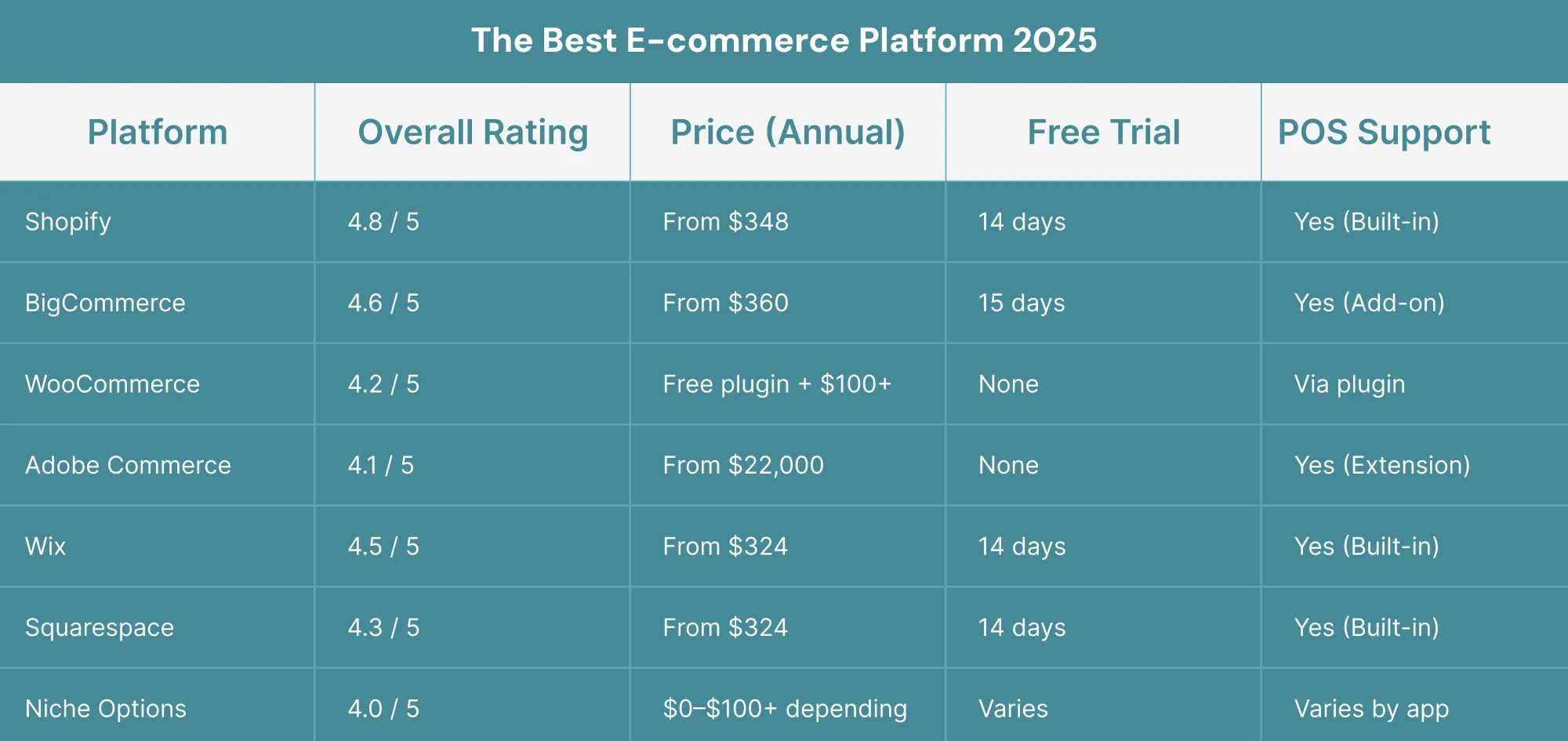- October 22, 2025
- Categories: Web Solutions
How to Choose the Best E-commerce Platform in 2025?
When people ask what an e-commerce platform is, think of it as an online engine for your shop. An e-commerce platform can help you create carts, run pages and manage shipping. All this with just a few clicks.E-commerce platforms are a big deal. Research shows that retail e-commerce sales are expected to exceed 4.5 trillion US dollars worldwide.The best e-commerce platforms provide services quickly. They keep stock updated and secure payments, so you don’t have to waste time fixing errors. With clear menus the mobile users can stay engaged and buy more. Choose one with the most efficient design and ease of use. This allows your shop to grow more and develop over time.
What Is an E-commerce Platform?
An ecommerce platform is the online engine for your store. This means that it can serve to power your shop and business. It lets you display your products and work. It can also let you show prices and variety of the products. The best e-commerce platform can also help with tax, stock and shipping. They can stop errors like selling out of stock items. With a simple setup you can track any payment made easily. It lets you list products, collect payments, and track orders. The best e-commerce platform will be built on scale so that it won’t slow if traffic jumps. This keeps your business smooth even as it is growing. It also provides you with analytics so you know which products are popular. Your platform may have extra features such as reward schemes, marketing emails and trend reports, so you stay on top of your game. A good e-commerce platform is the game changer you need to ensure your shop’s success.How to Choose the Best E-Commerce Platform for Your Business?
When evaluating the best e-commerce platform, these ten factors matter most:1. Easy Setup and Use
A guided wizard should be able to help you with setup. Drag‑and‑drop page builders let you build pages without coding. For example, Shopify lets you drag and drop pages in minutes. Live previews show time. A simple dashboard keeps your team in control. You will save hours on each update. A condition for the best e-commerce platform.2. Cost and Pricing
Plan ahead for the cost to avoid surprises. In order to create the best e-commerce platform, pricing must be taken into account. Add transaction charges, premium theme costs, app subscriptions, and any developer time. Add up small costs etc. Map out expenses for two years. This clear view helps you avoid hidden fees. A clear budget protects profit margins.
3. Scale and Reliance
Your store must stay fast when traffic spikes. Auto‑scaling servers and 99.9 percent uptime guarantees are vital. Even during busy times you wouldn’t lose any business. Reliable hosting means sales never stop. You want a partner that grows with your shop. An e-commerce platform that allows proper scaling is a must.4. Flexible Design and Customisability
Flexible design enables you to edit CSS. You can design a theme that matches your own taste. A good platform can allow you to edit layouts, fonts and colours. This customization can help you design your own unique style of commerce. Test theme code for quality and security. A flexible design system helps you match your brand and stand out with a look that feels your own. A unique look can go a long way in building trust with buyers. This is a must when evaluating the best e-commerce platform.5. Features and Apps
Content like SEO, recovery and discount tools are a must. A large app store fills gaps for subscriptions, print‑on‑demand, and advanced reviews. Check app ratings and update frequency. A thriving ecosystem ensures steady improvements. You should look for apps that integrate core values. More helpful features can save time and help the staff.6. Marketing and Growth
Built-in email platforms help in boosting traffic. As do Google Ads and analytics. Pop-ups and referrals can also bring in leads. Google Ads and Facebook fusions can help with the reach. Analytics provide real time results which can help you track progress.7. Payments and Checkout
Payments must be tracked and checked, so you know what goes in and what comes out. Safe payments can build trust with the customers. If you offer PayPal, Apple Pay and multi-currency support, it may attract global shoppers. A smooth flow will ensure less customers will abandon carts. Secure payment steps build customer trust.8. Support and Community
E-commerce platforms like Wix can provide 24/7 chat with tutorials that can fix issues quickly. Community support can make scaling easy. Forums can also help with issues through tips and hacks. Strong support frees your focus on sales and growth.9. Security and Compliance
An SSL certificate locks down your site so customer data stays safe. Fraud filters help stop fake orders. Auto updates and security patches can make sure that data remains safe even as you work. Customer disputes can be handled with chargeback systems. Be sure you know which security tools are included and which add‑ons carry a fee.10. Perfect Fit
Picking the best e-commerce platform means the tools fit the job. B2B sellers need bulk order support. Digital‑goods buyers may want secure download links. When your platform fits your model, you avoid extra costs.Picking The Best Ecommerce Platform Business Model
Not all online stores follow the same pattern. You must pick a model that fits your needs and market. Four main styles exist. Ecommerce platforms vary in how they support different models. So you must choose the model that fits your needs.B2C
B2B
C2B
C2C
Why Adopt a Dedicated E-commerce Platform
The best e-commerce platforms also ensure the safety of your payments. That can build trust with buyers. A strong platform allows you to update with less effort while also providing support.Creating a website from scratch can be tedious compared to building a store on a platform.. Today’s leading e-commerce platforms handle marketing, analytics, and security by default. Choosing the best e-commerce platform might be the game changer for you. Consider these six core gains:Speed to Market
Templates allow for a quick launch. You do not need coding skills or big budgets to start. You pick a design, add products, and start doing business. This quick start helps you test ideas and gather feedback. This makes you more aware of market trends in a shorter time.Low Startup Investment
A user friendly e-commerce platform. Most plans are very cheap. Many plans cost under $20 per month. A small fee is taken per sale but the marketplace is free to join. As you grow you can test product ideas. You can develop new themes, apps or custom tools, due to low cost. The system grows with you and never exceeds your budget.Shoppers Access
Most of the buyers prefer checking online before visiting a store. Accurate descriptions, clear photos and honest reviews can help them make wise decisions. This builds trust in shoppers, as they have ease of access to your goods.Data‑Driven Prospecting
Data analytics is key in every business. Most e-commerce platforms have built-in analytics or access to google analytics. These provide valuable information about customer habits. You get to see what visitors like and what they don’t. Email tools let you match these habits. Over time this data helps you sell more and smarter.Engaging Content
A good system allows engaging content to be shared with ease. You should be able to share videos, post blogs and guides. This allows for more user engagement. Tutorials and customer stories ensure trust. Content makes it easier to develop brands and keep it alive in the customer’s mind. This also helps with the sales. To avail best content creation for digital marketing, check out our content marketing services.Reaching Niche Markets
With a good platform you can appeal to multiple audiences at the same time. Your store can have sections with different products. This not only appeals to wider groups but also helps them find items fast. Focusing on niche markets can lead to better conversion rates. This also builds bonds and customer loyalty. Hence e-commerce platforms play a very important role for sellers with varied products.Key Trends Shaping E-Commerce Platform Choice in 2025
Certain trends stand out among e-commerce platforms. Certain shifts stand out and they will guide to choose the best e-commerce platform for your system:Mobile Kingdom
Mobiles are rapidly dominating the share of online retail sales. This trend seems to grow stronger with each year. Shoppers are now buying at their ease while travelling, on breaks or from home. A site must load in two seconds or less to convert casual viewers into buyers. Smooth path with one click mobile checkout can help reduce cart leaving.Headless and Flexible Commerce
A headless system allows you to split the front ( what users see) from the back end (engine). This system allows you to run websites, apps and even devices while retaining the core system. This also gives you freedom to design pages in the front while the engine keeps running in the back. APIs can help you switch tools on the fly without stopping the core. This flexible approach gives you freedom to grow as you like.
AI for Personal Touch
AI now encourages personal designs. This means that now you can create your own unique look while doing changes to fit each shopper. AI can suggest products, changes and ideas most suited for your needs. Many platforms are using AI. This must be checked often, as AI must not confuse the viewers. It should always serve to guide them. So keep checking on AI settings and control your tone. To learnSelling Everywhere
In our age, people expect to buy from everywhere. Be it social media, websites, apps, events or at stores, they expect a link to your shop at their disposal. The best e-commerce platforms bring all stock and orders in one place. This prevents errors like overselling or selling out of stock items. One report can show the full picture. This brings clarity to your venture and helps you plan with confidence and knowledge.Profiles of the Top E-Commerce Platforms
After you have decided on your needs, all that remains is the choice that fits. Some of the best e-commerce platforms are provided to help you select. This view will help you match your needs.1. Shopify
Shopify is in the lead for new stores. It can give you multiple setups. It is fully hosted and can help you with over 100 themes. You don’t have to worry about security or fixes. This is an ideal fit for new brands. Many brands have been created here and stayed since. The ease of use and clarity makes it an easy leader among the best e-commerce platforms. To learn more about how to rank higher and have better SEO with shopify, do check out our blog on Shopify SEO.2. BigCommerce
BigCommerce is most growth friendly. It doesn’t have any sales cost. You are in control of SEO settings including even robots.txt and meta tags. It also allows multi-currency sales which makes global reach easy. Uptime is nearly perfect with great scaling. Expert support is provided and APIs allow for custom designs.3. WooCommerce
WooCommerce can turn any WordPress site into a shop. It is also free. Themes and add-ons are cheap. You can easily install extensions and it’s cheap as you only pay for extras. A big community supports it with fixes and advice.It is best suited for marketers with digital products and content. A warning as it can be unsuitable for beginners. If you are looking for the best e-commerce platform for WordPress websites then WooCommerce is your number one option. To avail great results with wordpress check out our wordpress development services.4. Adobe Commerce (Magento)
Adobe Commerce is made to handle big stores and complex operations. It allows wholesale e-commerce and multiple pricing tiers from a single dashboard. Brands have the freedom to choose whatever hosting that suits their needs.It also allows for headless e-commerce capability letting you customize as you grow. Its powerful backend will ensure smooth running even as changes are being made. This platform is more suited for those with technical skill. Its biggest pros are unmatched flexibility and scalability.5. Wix and Squarespace
Wix and Squarespace are a simple platform for small shops. They have built-in blogging tools, image galleries and checkout functions. They have easy drag and drop options for building a store that needs no coding. For small sellers and content creators with catalogues under 100 items, it works best.6. Niche Alternatives
There are also niche alternatives which serve specific needs. Big Cartel is ideal for artists with its simple design and low fees. For print-on-demand services we have Printful and DSers. For self-hosted shops desiring freedom Shift4Shop and OpenCart offer free and full access. These platforms are for niche users who have specific needs. They offer creative control and freedom but lack some of the useful features of big platforms.7. A Choice: The Best E-commerce Platform 2025
The choice for the best e-commerce platform in 2025, is down to your needs. You must assess them. Then make a choice for the best fit for you. An e-commerce platform should have the tools that serve your needs. Therefore it’s important to make sure that you have the right priorities.
Secure the Best E-commerce Platform
Choosing the best e-commerce platform isn’t about a ranking system. It’s about what fits your needs and desires. You have the data now it’s time for action. You must start by setting your priorities right, look for what’s most suitable for your taste and needs. Write down your most desirable features like SEO tools, flexibility, payment options and mobile optimization. Now compare each option for your features and analyse it against your budget, ease of use etc. This way you can realize where strengths and gaps lie in each option. To make sure you secure the best E-commerce platform, check out our E-commerce website development services.We at XoomPlus analyze your results with free trials and demos. This will show you the pros and cons of your choice in full detail. You can add products, reviews and process orders to know how checkout feels on mobile. Involve yourself and your team to get feedback on the most suitable fit for you.Above all base your views on hands-on testing not by just claims. This makes sure that you are protected from hidden costs and fees. Make your own opinion based on your needs. The best e-commerce platform in 2025 may just be right around the corner for you.Ready to launch or upgrade your online store?
Choose the best e-commerce platform for your business today and start selling smarter in 2025.
Faqs
An ecommerce platform is the software that runs your online store. It handles product pages, carts, payments, shipping and taxes all in one place. Choosing the right platform saves you time on technical tasks and lets you focus on selling products and growing your brand.
Hosted platforms include servers, security and updates for one monthly fee. They let you skip server setup and concentrate on your store. Self‑hosting gives you full control over settings and custom code but demands you handle maintenance, patches and scaling yourself. Your choice depends on how much technical work you want versus how much control you need.
Focus on mobile‑friendly design, fast page loads, secure checkout and easy inventory management. Look for built‑in marketing tools such as email campaigns and SEO controls. If you sell in person, check for native POS support. These core features ensure your store meets customer expectations and scales smoothly.
Add up the base subscription, transaction fees, premium themes, essential apps and any developer hours you expect. Map out your budget over two years to spot hidden costs. This clear comparison helps you choose the most cost‑effective platform for your sales volume and growth plans.
Yes, but migrations can be time‑consuming and costly. To avoid painful replatforming, choose a system today that can grow with your products, traffic and sales channels. Test live trials and gather team feedback to ensure the platform you pick has the flexibility to adapt to new markets and business models.

